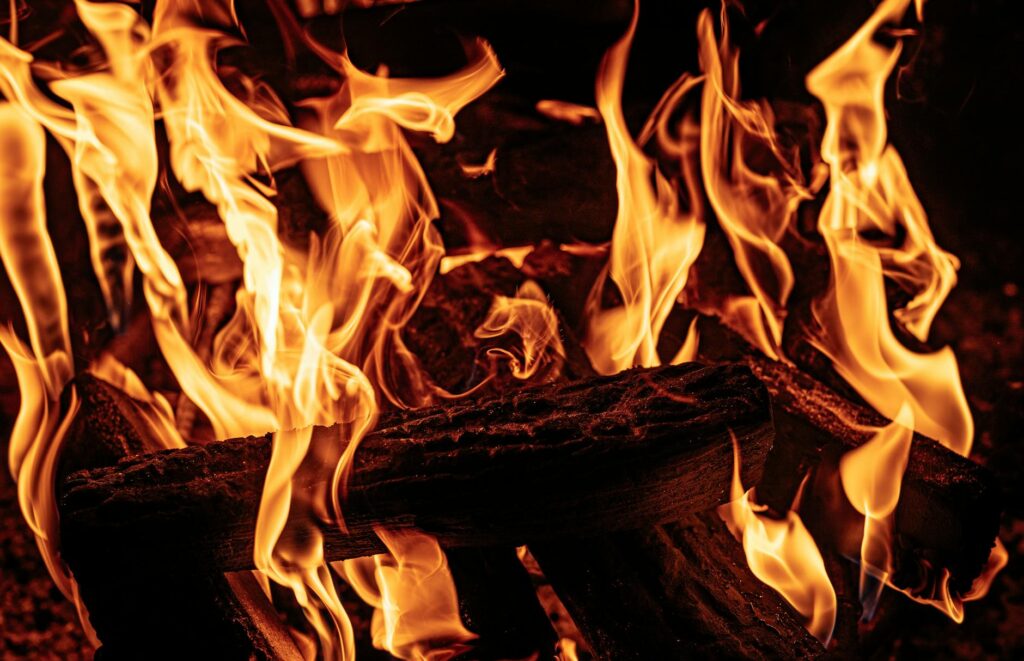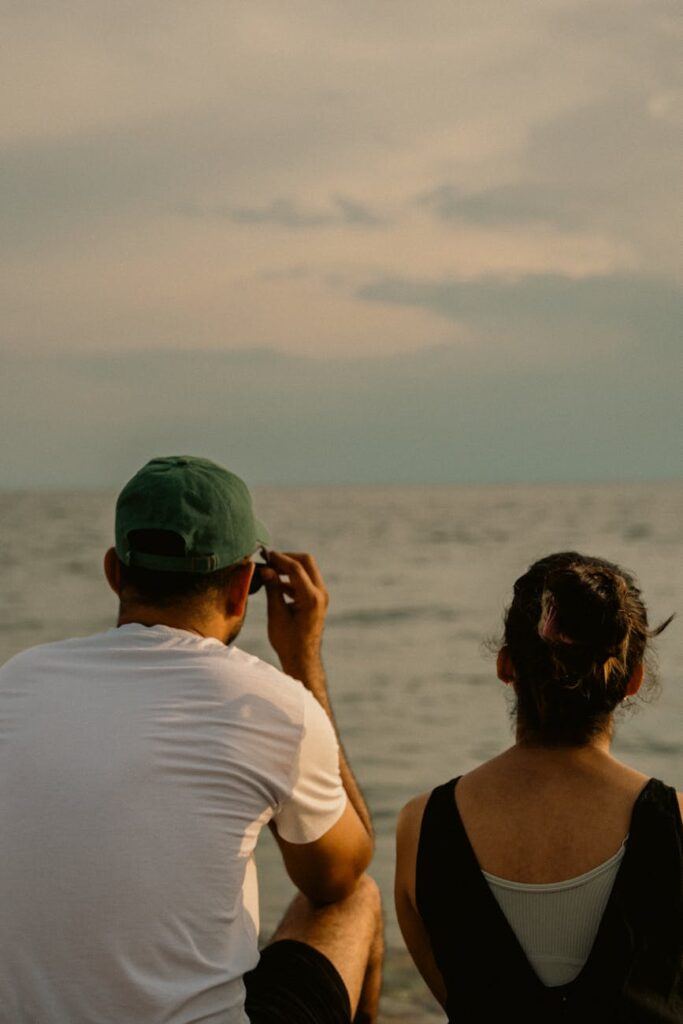The Primal Pull of Fire and Water
There’s a reason we’re drawn to it. A reason why, as the sun dips below the horizon, painting the sky in fiery strokes of orange and purple, the idea of a crackling fire on the sand feels less like an activity and more like a calling. An evening fire on the beach is more than just a way to stay warm; it’s a multisensory experience that taps into something ancient and deeply embedded within our DNA. It’s a ritual as old as humanity itself, a communion of two of nature’s most powerful and mesmerizing elements: the endless, rhythmic pulse of the ocean and the wild, dancing energy of the flame.
Think about it. The day is done. The heat has faded, replaced by a cool, salty breeze. The chaotic energy of the daytime beach—the frisbees, the shouting, the bustling crowds—has dissolved into a profound and beautiful quiet. It’s in this space that the ritual begins. The scrape of a match, the catch of a flame on dry kindling, and the slow, steady growth of a warm, golden light that pushes back the encroaching darkness. This isn’t just about s’mores and ghost stories, though those are certainly welcome. This is about reconnection. It’s about finding a moment of stillness in a world that never stops moving, and grounding yourself in the simple, profound beauty of the present moment.
Key Takeaways
This post explores the deeply calming effects of a beach bonfire. You’ll learn not just the ‘how-to’ but the ‘why’—from the psychological benefits of fire-gazing to the practical steps for planning a safe, respectful, and memorable experience. We’ll cover everything from choosing the right spot and gear to the unwritten rules of beach bonfire etiquette, ensuring your coastal fire is a restorative ritual, not a regrettable mistake.
Why We Crave the Coastal Campfire
What is it about this specific combination that feels so right? It’s not just a coincidence. Psychologists and anthropologists have long studied our innate attraction to these elements. The concept of ‘biophilia,’ popularized by biologist E.O. Wilson, suggests that humans have an inherent tendency to seek connections with nature and other forms of life. An evening fire on the beach is biophilia in its purest form.
The fire itself is a source of ‘soft fascination.’ Unlike the ‘hard fascination’ of a blaring television or a buzzing phone, which demands our full attention and can lead to mental fatigue, a flickering flame captures our attention effortlessly. It’s dynamic but not demanding. This allows for a state of relaxed contemplation, where our minds can wander, reflect, and de-stress. It’s a natural form of meditation. The rhythmic, predictable sound of the waves crashing on the shore has a similar effect, proven to lower cortisol levels and induce a state of calm. When you combine the two, you create a powerful, natural sanctuary for the mind.
The Sensory Symphony of a Beach Bonfire
The true magic lies in the complete sensory immersion. It’s a symphony where every sense is engaged, pulling you completely into the present.
- Sight: Your world shrinks to the circle of light cast by the flames. The fire is a living entity—leaping, dancing, and casting flickering shadows on the faces of your companions. Beyond the firelight, the vast darkness of the ocean stretches out, punctuated only by the brilliant pinpricks of stars or the gentle glow of the moon on the water. It’s a visual feast of contrasts: light and dark, warmth and coolness, intimacy and immensity.
- Sound: It’s a duet. The sharp, percussive crackle and pop of the burning wood plays against the deep, resonant bass of the crashing waves. It’s a soundtrack that’s both exciting and soothing. Conversations around a fire are different, too. Voices are softer, laughter feels richer, and comfortable silences are just as meaningful as the words spoken.
- Smell: The aroma is unmistakable and evocative. The sharp, clean scent of the salty air mingles with the rustic, earthy smell of burning wood. Add the sweet, caramelizing sugar of a toasted marshmallow, and you have a perfume that can instantly transport you back to your happiest memories. It’s the scent of simple joy.
- Touch: The experience is a study in tactile contrasts. There’s the intense warmth of the fire on your face and hands, a welcome comfort against the cool night air on your back. Then there’s the feeling of the cool, soft sand beneath your blanket or between your toes. It’s a physical reminder of your connection to the earth.
- Taste: While not the primary sense, it’s often the most memorable. The smoky char on a hot dog, the gooey perfection of a s’more, the simple comfort of a warm drink from a thermos—these tastes become inextricably linked to the experience, sealing the memory in a way nothing else can.

The Practical Magic: Planning Your Perfect Evening Fire on the Beach
As romantic and spontaneous as it sounds, a successful and responsible beach bonfire requires a bit of planning. The goal is to create a magical evening, not a logistical nightmare or an environmental hazard. Thinking ahead is the key to relaxation.
First and Foremost: Check Local Rules and Regulations
This is the absolute, non-negotiable first step. Ignoring local ordinances can result in hefty fines and, more importantly, can be incredibly dangerous. Every coastal town and state park has different rules. Here’s what you need to look for:
- Are fires allowed at all? Some beaches have outright bans, especially during dry seasons.
- Do you need a permit? Many places require you to obtain a fire permit in advance. These are sometimes free but often require a visit to the local fire department or parks office.
- Are there designated fire pits? The best and safest option is to use a pre-existing, designated fire ring. If not, are you allowed to dig your own pit? There are usually rules about how far it must be from dunes, vegetation, and the high-tide line.
- What kind of wood is allowed? Never burn driftwood, as it releases harmful chemicals when burned. You also can’t burn treated wood like pallets or construction scraps. You’ll need to bring your own clean, seasoned firewood.
- What are the time restrictions? Many beaches require fires to be extinguished by a certain time, often 10 or 11 PM.
A quick search for `”[Beach Name] + bonfire rules”` or a call to the local Parks and Recreation department will give you all the information you need. Do not skip this step.
Gathering Your Gear: The Bonfire Toolkit
Once you know the rules, it’s time to pack. Having the right gear makes everything smoother and safer. Think of it in categories:
- Fire Essentials: This is your safety and fire-starting kit. You’ll need a sturdy metal bucket (for water to douse the fire), a shovel (for moving sand and embers), a reliable lighter or waterproof matches, fire starter or dry kindling (newspaper, dryer lint, or commercial fire starters work well), and of course, seasoned firewood. Bring more water than you think you’ll need for extinguishing the fire.
- Comfort Essentials: The sand gets cold and damp after sunset. Pack old blankets or tarps to sit on, comfortable beach chairs, and warm layers of clothing. A hoodie, a warm hat, and thick socks can make all the difference between a cozy evening and a shivering retreat.
- Fun & Food Essentials: This is the good stuff! Pack long-handled roasting sticks for marshmallows or hot dogs. Bring a cooler with drinks and snacks. Don’t forget the classic s’mores ingredients: graham crackers, marshmallows, and chocolate bars. A portable speaker for some low-volume background music can be nice, but be respectful of others. And absolutely bring a flashlight or headlamp for navigating in the dark and for the final cleanup.
Building the Perfect, Safe Beach Fire
Building a fire on the sand is a little different than in a forest. Start by choosing your spot carefully—well away from the dunes and below the high-tide line so the ocean can wash it clean, but not so close that an incoming wave will extinguish it prematurely. If there are no designated rings, dig a pit about one to two feet deep and a few feet across. This helps contain the embers and shields the flame from the wind.
Use the ‘teepee’ or ‘log cabin’ method to stack your wood. Start with a small bundle of tinder and kindling in the center. Light the tinder from the bottom, allowing the flames to catch the smaller sticks above it. Gently blow on the base of the fire to give it oxygen. Once the kindling is burning well, you can start adding your larger logs. Start small and build it up slowly. A smaller, manageable fire is often more enjoyable and safer than a massive, raging bonfire.
Beyond the S’mores: Rituals to Deepen the Experience
A fire can be more than just a heat source; it can be a centerpiece for connection and reflection. This is how you transform a simple bonfire into a truly calming ritual.

Practice Mindful Observation
For at least a few minutes, put everything down. No phone, no food, no talking. Just watch the fire. Notice the colors—the deep red at the heart of the embers, the brilliant orange and yellow of the flames, the blue licks of gas at the base of the logs. Listen to its voice. Let your mind quiet down and just be present with the raw, beautiful energy in front of you. It’s a simple act of mindfulness that can have a profound impact on your state of mind.
Cultivate Connection and Conversation
There’s a reason humans have gathered around fires to tell stories for millennia. The darkness beyond the firelight creates a bubble of intimacy, encouraging a different kind of conversation. It’s the perfect setting for sharing stories, reflecting on the day, or talking about dreams for the future. Make a pact to put phones away. The absence of digital distraction allows for genuine, uninterrupted connection with the people you’re with. You’ll be amazed at the quality of conversation that emerges when you’re just focused on each other and the flames.
The fire asks for nothing but your presence. In return, it offers warmth, light, and a space for the kind of quiet reflection that is so hard to find in our busy lives.
A Time for Personal Reflection
If you’re alone or just seeking a moment of solitude, the fire can be a powerful tool for introspection. Think about something you want to let go of—a stress, a worry, a negative thought. Visualize yourself writing it on a piece of wood and placing it in the fire. As you watch it burn and turn to ash, consciously release it. Conversely, you can use the fire to set an intention. As you look into the vibrant, creative energy of the flames, think about something you want to bring into your life. The fire becomes a focal point for your thoughts and intentions.
The Bonfire Code: Leave No Trace
The final, and perhaps most important, part of the ritual is how you end it. The goal is to leave the beach as if you were never there, or even better than you found it. The ‘Leave No Trace’ principle is paramount for ensuring these beautiful places remain accessible for everyone.
Extinguish Completely: This is critical. Don’t just bury the fire with sand. This insulates the hot coals, which can stay dangerously hot for hours, posing a severe burn risk to unsuspecting beachgoers (especially children and pets) the next day. Douse the fire thoroughly with your bucket of water. Stir the embers with your shovel and douse them again. Repeat until you can safely touch the area with your bare hand. It should be cool to the touch. No steam, no hissing, no heat. Cold out.
Pack It In, Pack It Out: Everything you brought with you must leave with you. This includes food wrappers, bottles, cans, and even tiny scraps of paper. Do a final sweep of your area with a flashlight before you leave. Go the extra mile and pick up any other trash you see nearby.
Fill the Pit: Once the fire is completely out and cool, fill the pit you dug with the sand you removed. Level it out so the beach is smooth and safe for the next visitor.
Conclusion
An evening fire on the beach is a simple pleasure with profound benefits. It’s an escape, a meditation, a social gathering, and a personal ritual all rolled into one. It’s a chance to disconnect from the digital noise and reconnect with the natural world, with the people we care about, and with ourselves. By planning ahead, respecting the rules, and embracing the sensory experience, you can tap into an ancient source of comfort and wonder. The next time you feel the pull of the coast as evening falls, answer the call. Build a fire, watch the flames dance against the backdrop of the sea, and let its warmth seep not just into your skin, but into your soul.



 The Digital Postcard: A Guide to Mindful Photo Sharing
The Digital Postcard: A Guide to Mindful Photo Sharing  Discover Serenity: 7 Peaceful Architectural Styles
Discover Serenity: 7 Peaceful Architectural Styles  Beat Museum Burnout: Enjoy Your Visit Without Exhaustion
Beat Museum Burnout: Enjoy Your Visit Without Exhaustion  A Guide to the World’s Most Beautiful Fountains
A Guide to the World’s Most Beautiful Fountains  World’s Most Peaceful Public Transportation Systems: A Guide
World’s Most Peaceful Public Transportation Systems: A Guide  Ancient Wewas of Sri Lanka: A Timeless Water Legacy
Ancient Wewas of Sri Lanka: A Timeless Water Legacy  DeFi’s Hurdles: Security, Scalability & Regulation
DeFi’s Hurdles: Security, Scalability & Regulation  How to Read a Crypto Whitepaper: A Beginner’s Guide
How to Read a Crypto Whitepaper: A Beginner’s Guide  Find Undervalued NFT Projects: A Complete Guide
Find Undervalued NFT Projects: A Complete Guide  Blockchain Consensus Mechanisms Explained (PoW vs. PoS)
Blockchain Consensus Mechanisms Explained (PoW vs. PoS)  NFTs & Music: Empowering Artists in the Digital Age
NFTs & Music: Empowering Artists in the Digital Age  Trader’s Psychology: Master Fear & Greed in Markets
Trader’s Psychology: Master Fear & Greed in Markets